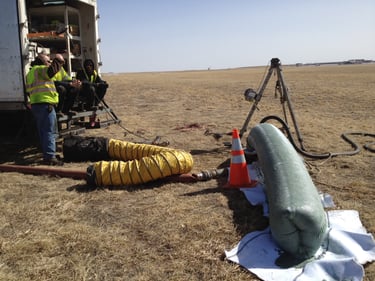When it comes to pipeline rehabilitation, there is no one-size-fits-all solution. As technology advances, new curing methods are established, and the options for cured-in-place pipe (CIPP) lining continue to expand. From hot water and steam curing to UV curing, there are multiple factors to consider before deciding which CIPP lining method to use.
background of CIPP Lining
 CIP pipe lining was first introduced in 1971 and has since become the most widely-used rehabilitation method for sewers and storm pipelines. The trenchless sewer pipe repair method requires little to no digging, minimizing environmental impact and using less time to complete than more invasive sewer repair methods.
CIP pipe lining was first introduced in 1971 and has since become the most widely-used rehabilitation method for sewers and storm pipelines. The trenchless sewer pipe repair method requires little to no digging, minimizing environmental impact and using less time to complete than more invasive sewer repair methods.
The lining process requires inverting or pulling a flexible felt or fiberglass liner inside a degraded pipe, and inflating the liner to press against the inside walls. The liner may be exposed to heat or ultraviolet light (UV) to cure and harden.
Hot Water and Steam Curing
Using hot water to cure a pipe was the original method for CIPP lining techniques. While it’s still used today, other methods have become more common. One of these is steam curing. This curing process is typically faster than hot water, because steam transfers heat more quickly than water. There are advantages and disadvantages to both methods.
While hot water curing has a lengthy history and proven track record, steam curing also requires less water supply and access, and it allows for steep slope installations.
But steam has its disadvantages, too. There are pipe length and thickness limitations, whereas water curing accommodates longer pipes and larger diameters. Another potential risk of steam curing is a blistering of the liner caused by the heat, which can inhibit flow and cause blockages or accelerate degradation of the liner.
Whether curing with water or steam, it’s important to consider community effects as well. Most heat-cure resins release an odor often described as similar to plastic or glue. The odor comes from styrene, which is the liquid that reacts with heat and hardens to form the liner. There has long been debate over whether there are health impacts from ingesting these emissions. Because heat and steam curing use multi-part resins, mixing the resin with a catalyst to cure, the risk of mixing chemicals with sewer water also exists.
UV Curing
A more modern method of CIPP is UV curing, which uses no water at all and cures with fiberglass instead of felt. A Glass Reinforced Polyester (GRP) liner is impregnated with a unique resin into the sewer or drain.

The liner is inserted into the host pipe and then inflated with air. UV lights are run through the pipe, which prompts the resin to cure.
UV curing is conclusively a stronger and more durable method, and it takes significantly less time. It also has an even smaller environmental footprint. And unlike heat curing, UV curing has no styrene emission due to encapsulations, which seal and limit the potential for any harm or disruption.
The process of UV curing, however, requires a greater investment than other options and is limited to certain pipe sizes.
UV LED Curing
While traditional UV curing methods are limited to fiberglass liners, new UV LED solutions like the SpeedyLight+ system from Pipeline Renewal Technologies expand the options.
The SpeedyLight+ system is compatible with both felt and fiberglass, and it uses a single-component resin that cuts time and limits the risk of mixing chemicals with sewer water during the curing process. Because it uses a single-component resin, if the liner is overfilled excess resin can be saved and reused for another job. The UV LEDs in SpeedyLight+ also use three times less energy than lamp-based UV technology while emitting four times more UV radiation.
There are many factors to take into consideration when deciding which CIPP lining process to use. While UV curing methods may be more effective and have a smaller environmental impact, the high cost is an important factor for many contractors and system managers. Formulating a plan based on your needs, budget, resources and timeline is the first step when deciding how to cure old and damaged pipelines.
Image Courtesy of U.S. Department of Agriculture via Flickr CC BY 2.0
Image Courtesy of U.S. Air Force/Lea Johnson via Peterson Air Force Base
